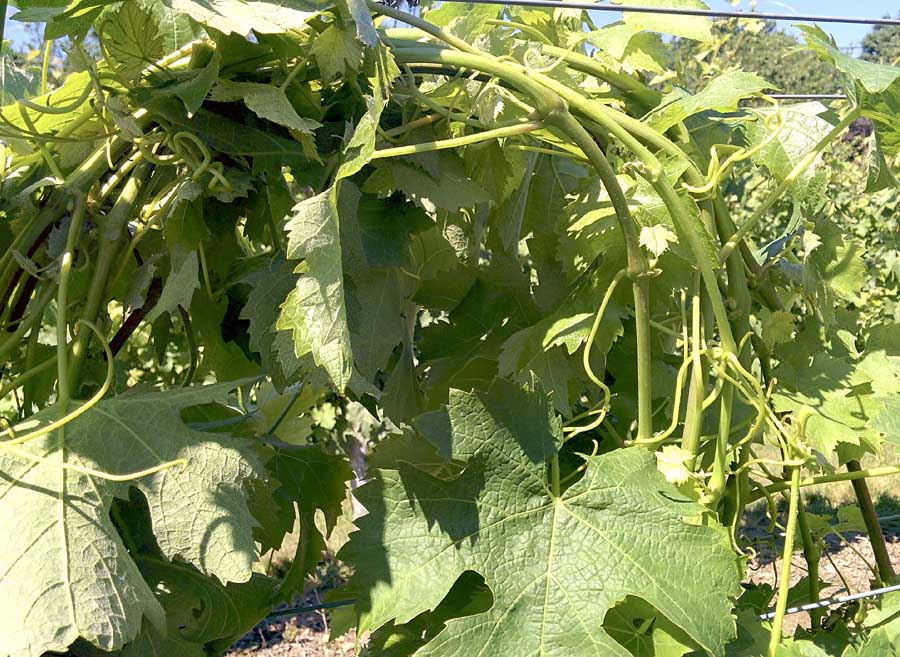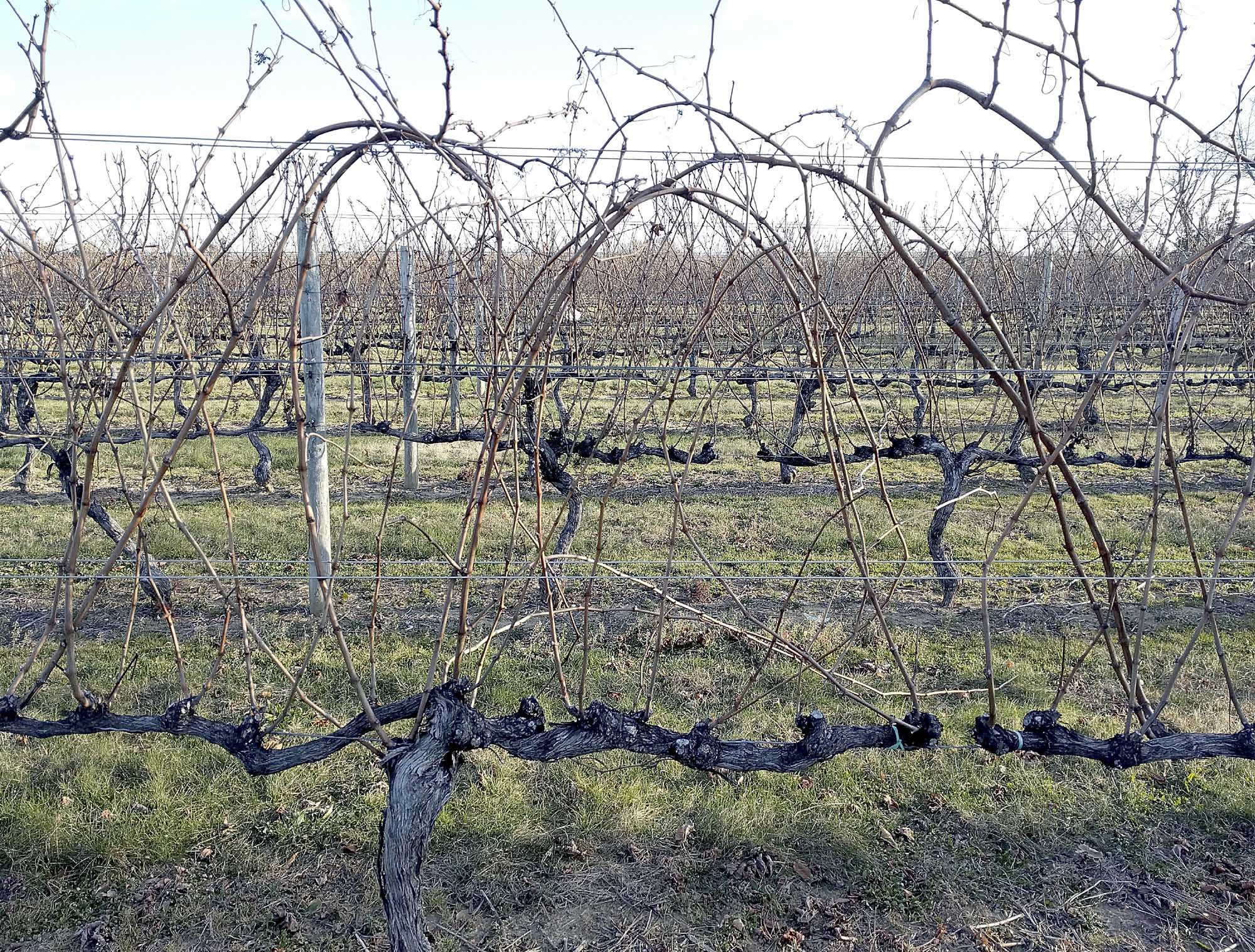
Wrapping shoot tips that extend above the canopy around the top trellis wire appears to be a promising alternative to repeated hedging for some wine grape cultivars, according to Cornell University Viticulture Professor Justine Vanden Heuvel. The technique, known as palissage, is shown here on Syrah at Cornell’s Long Island Horticultural Research and Extension Center. (Courtesy Justine Vanden Heuvel)
Wine grape vineyards need canopy control to produce high quality fruit, but the hedging technique commonly used in cool growing regions is a Band-Aid, not a solution.
Hedging just spurs more shoot growth, which leads to more hedging, and spurs unwanted lateral growth, said Cornell University viticulture professor Justine Vanden Heuvel.
“It’s the shoot tips that are producing auxin, the growth hormone that’s producing the lateral growth in the fruit zone,” Vanden Heuvel said. “It gets you into this vicious cycle, and then the laterals go ‘whoosh’ and your fruit zone gets really crowded.”
That’s why her research program is focused on alternative means for controlling canopy vigor in a region with rich soils and plentiful rain, such as using cover crops as competition on the vineyard floor and a training technique with French roots called palissage, which shows promise for replacing hedging in some vineyards.

The use of palissage, the practice of wrapping or tucking vigorous shoot tips to control canopy growth is shown here on Syrah at Cornell’s Long Island Horticultural Research and Extension Center. (Courtesy Justine Vanden Heuvel)
Palissage involves wrapping shoots along the top catch wire in a VSP system, or tucking the shoots down into the interior of the trellis.
This reduces vigorous growth and seems to quell the hormone response that comes from cutting off those shoots and drives lateral growth in the fruiting zone. The mechanism hasn’t been rigorously proven yet, but the wrapping technique, Vanden Heuvel’s preference, almost always leads to reduced lateral number and length, she said.
She began to study the concept after Thom Bechtold, then the vineyard manager for King Ferry Vineyards, in King Ferry, New York, started experimenting with the technique after learning about it during a conference presentation by French grower Olivier Humbrecht.
Bechtold began tucking shoots in 2009 and within a few years, he was using it across the 30-acre vineyard of Riesling, Chardonnay and Cabernet Franc and collaborating with Cornell to study the impacts.
“The benefit was that if you are not hedging your vines, you don’t end up with half a dozen laterals and all those leaves making a mess of your fruiting zone,” he said, adding that he found the long-term benefits even better than the short term.
“After four or five years, it seemed pretty apparent to us — with the exception of vines growing in very deep soils that have an endless supply of water — that their growth was constrained. The vines were gradually getting smaller and having less leaf cover,” Bechtold said. He also said he used both palissage and cover crops to limit growth.

Tucking the shoots back down into the canopy is the preferred method of palissage for Thom Bechtold, the former vineyard manager at King Ferry Vineyard, where this photo was taken in a Riesling block. (Courtesy Justine Vanden Heuvel)
Vanden Heuvel said that she wants several more years of data to corroborate Bechtold’s observations on vine size control, but said that it’s very promising.
The shoot wrapping technique also appears to reduce cluster compaction by causing the rachis to elongate further than normal, so the same number of berries have more space. This benefits tight clustered cultivars such as Riesling in particular, Vanden Heuvel said, reducing botrytis incidence and severity because there is better air flow through the cluster.
“So far, our results have been quite positive. The problem is that this has to be done by hand and it takes a while,” she said. “Hedging is cheap, but the thing is you have to keep doing it.”
And the labor cost for the palissage could pay off for some vineyards if it continues to result in more open fruiting zone, allowing for improved spray penetration and air flow and reducing required fungicide sprays. She is working with a Cornell economist and growers to estimate the costs and benefits of implementing the technique.
Growers in the Finger Lakes region of New York who tried the technique haven’t all had the same success as Bechtold.
Tom Higgins, co-owner of the Heart and Hands Winery, tried the shoot wrapping approach for two years on his Pinot Noir and found that it increased disease pressure in his vineyard and made pruning more complicated and time consuming.
The wrapped shoots held pockets of water that became a home for downy mildew, he said. That was “a deal breaker” for his operation, but he also didn’t see the time savings compared to hedging he sought.
“It was difficult to unwrap the shoot we wanted to use for next year’s fruiting cane; we had to go about methodically unweaving it,” Higgins said. “It took twice as long for my staff, who are experienced pruners, to navigate the canopy in that area.”
So, he’s gone back to hedging, which he does on the 4-acre vineyard by walking the rows hauling a shrub hedger on his shoulder, and leaf pulling.

Riesling vines where the shoot tucking method was used to limit canopy growth await pruning at King Ferry Vineyard. Using palissage in conjunction with strict balance pruning and cover crops reduced vine size in the long term, said Thom Bechtold, former King Ferry Vineyard manager. (Courtesy Justine Vanden Heuvel)
At his vineyard, Bechtold said he chose the tucking method rather than wrapping because it’s faster, and workers can tuck a handful of shoots at once.
It works best in conjunction with strict balance pruning to keep vine size in check, he added. He suggested that other growers who want to try the technique train their workers, be careful about timing and adopt the practice along with cover cropping and balance pruning.
“If we got the timing right, it paid for itself and was worth it,” Bechtold said, but since the ideal time for the shoots is late June and early July, it can be hard to squeeze in between rain and the fungicide schedule. “They get a couple feet above the trellis system and then you can bend them back in. Test it when you are out scouting. If they break, don’t do it.”
You can see that it’s working if the shoot tips drop off around veraison and go into dormancy, he said.
Next steps for the Cornell research project include looking at vine roots to ensure that palissage is not having a detrimental effect on root growth, and trying to figure out what plant hormones are responsible for the rachis elongation and reduced lateral growth, Vanden Heuvel said.
There’s also more viticulture work to be done to see what cultivars gain the most from the practice and how best to time and fine-tune it.
“On the whole, this is not a technique that everyone wants to use,” she said. “But for growers who want to fine-tune canopy management, it’s promising.” •
—by Kate Prengaman






[…] Good Fruit Grower – 2/5/2018 – Finger Lakes viticulture explore ‘palissage’ canopy management practice as an alternative to hedging. […]
Interesting…
I have a question and please help me if you have some data. What about the forming of buds for next year?
Considering that auxins prevail during vegetation, how do the buds differentiate for the next season? And what about the accumulation of sugar in clusters, given that the leaves on the lateral shoots in the second half of the vegetation have up to 40% higher photosynthetic activity.
Thank you in advance…